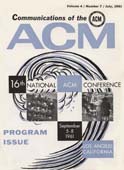July 1961 - Vol. 4 No. 7

Features
An algorithm for equivalence declarations
Many algebraic translators provide the programmer with a limited ability to allocate storage. Of course one of the most desirable features of these translators is the extent to which they remove the burden of storage allocation from the programmer. Nevertheless, there are situations in which one wishes to make certain vectors and arrays contiguous, coincident, or overlapping. This is made possible in FORTRAN by the use of COMMON and EQUIVALENCE statements, in MAD by the use of PROGRAM COMMON, ERASABLE, and EQUIVALENCE statements, etc.
Manned simulation research in complex control systems
Two purposes guide the studies currently in progress in the RAND Logistics Systems Laboratory: one is to aid the Air Force in a substantive management or control problem, such as operations-support control of the ICBM force, or control and allocation of resources to perform the short-term job of procuring, repairing and distributing the Air Force's supply assets; and the second is to improve the RAND use of abstract (primarily, manned computer-assisted) simulations in designing and evaluating alternative, complex control systems.
An experimental computer program for hypothesis selection
An algorithm for finding the characterization of a class of objects on the basis of a randomly ordered sequence of labeled individual objects—some members of the class, some not—is described. The class is characterized as a disjunction of terms, each term being a conjunction of attributes. “All red, round objects or all square, small objects” is an example. Mechanisms based on this algorithm are described in terms of such properties as the amount of storage available for recording instances and the number of instances which had to be examined until the class was first guessed.
Glossaries for computing and data processing
At the present time, there is considerable interest and activity in the preparation of a comprehensive glossary of computing and data processing terms. This interest is generated by members of the various national and international professional associations, the computer manufacturers, and the American Standards Association.



